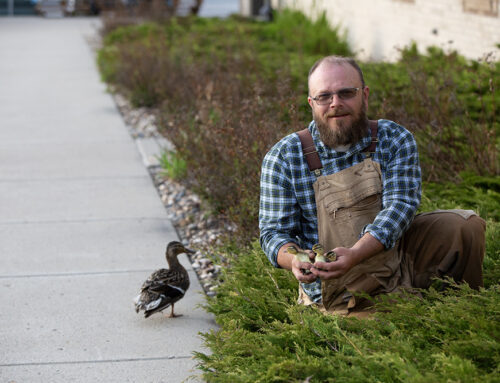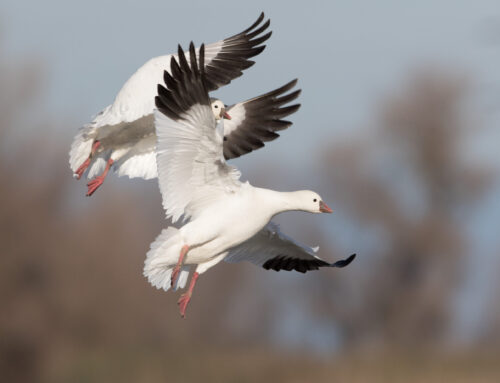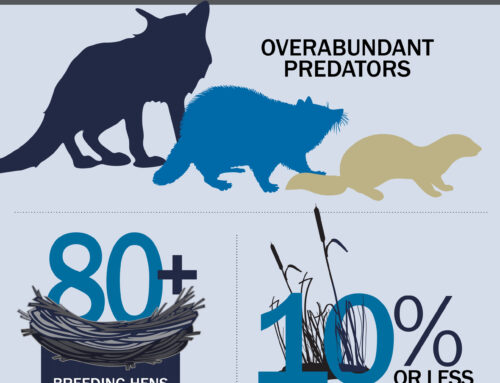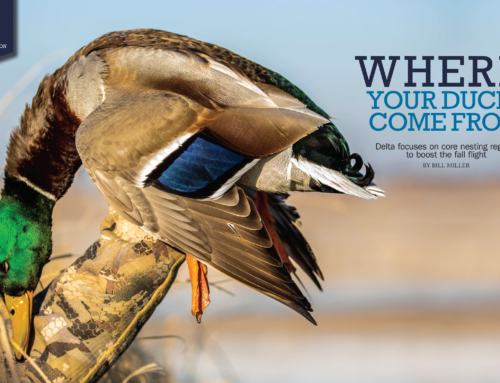What Do Ducks See?
Here’s why ducks are adept at spotting shiny faces and fidgety Labs

As we sit in the blind and anticipate the morning ahead, our minds can get stuck in a daydream. We may picture the array of colors on a wood duck or on an acrobatic flock of teal buzzing past. And this can lead us to wonder: Do the ducks see what we see?
Although the sensory systems of ducks (and many other avian species) have yet to be intricately researched, hunters still ponder why it seems that a subtle movement or flick of the head in the duck blind can cost the group a working flock. Here is where the science has led us thus far.
Panoramic Peripherals
Similar to many prey species, ducks have “monocular” vision, which refers to the placement of their eyes.
“With eyes set on the sides of their head rather than facing forward, ducks are able to pick up on movement rapidly and observe a significantly smaller blind spot than humans,” said Dr. Chris Nicolai, Delta’s waterfowl scientist. “It grants them peripheral vision that approaches 360 degrees.”
Monocular vision protects ducks by assisting in their ability to detect threats from any direction. Each eye is controlled independently, rather than both eyes viewing the same object at once, which further expands their panoramic view. Additionally, as described by the Iowa Department of Natural Resources, ducks bring the panorama into focus through “controlling the curvature of both their lenses and corneas (outermost surfaces of the eyes), which allows them to make adjustments for seeing in both air and water.”
“We do know that a duck’s eyesight is extremely strong,” said Nicolai. “Their attention to detail—and sensitivity to movement, in particular—is biologically programmed to keep them out of harm’s way.”

In Living Color
Truly testing what a duck can see would likely involve experiments with ducks trained to react to color changes—similar to research that has been done with dogs. However, for now we must look elsewhere for insights.
“There’s a strong argument for a duck’s ability and extent of seeing color by simply looking at the animal itself,” said Nicolai. “Nature gives us a plethora of interesting insights. Deer, for example, are known to not see color—hence why hunters can wear blaze orange for safety without the risk of blowing their cover.”
On the other hand, ducks—especially drakes—are greatly admired for their beautiful color schemes, and visual evidence is displayed through courtship behaviors.
“Although drakes choose which hens they court, hens select the drake that catches their attention, or puts on the greatest display,” said Nicolai. “This indicates to us that they do in fact see some types of color variation, likely more than we may be able to understand at this point.”
Existing studies suggest ducks have the ability to see colors the human eye cannot, such as shorter-wavelength colors and, likely, even the ultraviolet spectrum.
“Because they are able to see shorter wavelengths (close to UV), they have additional color receptors that we as humans do not,” said Nicolai. “Although it creates poor night vision, these color-receptive cones within the retina help ducks form crisp images. Interestingly, waterfowl have one of the most highly developed retinas found in nature.”
Most avian species—including ducks—have long-, medium-, and short-wavelength cones, similar to those of humans. The difference lies in ducks’ possession of a specific cone type that enables them to perceive wavelengths approaching the ultraviolet range.
“There is a great diversity of animals that can visually detect UV light; ducks are similar in that aspect,” said Nicolai. “Science also points to the fact that ducks, and many birds in general, possess a ‘double cone’ that humans don’t have—though there are still uncertainties as to how and why it functions. Lots of questions remain because a majority of the funding we get for research is focused on ways in which we can produce more ducks.”

Open to Debate
So, do ducks see what we see? Not exactly. But fortunately for all the duck-blind theorists out there, the topic remains open for exploration.
Staff writer Christy Sweigart and summer intern Angela Cook are members of Delta’s communications team.






Leave A Comment